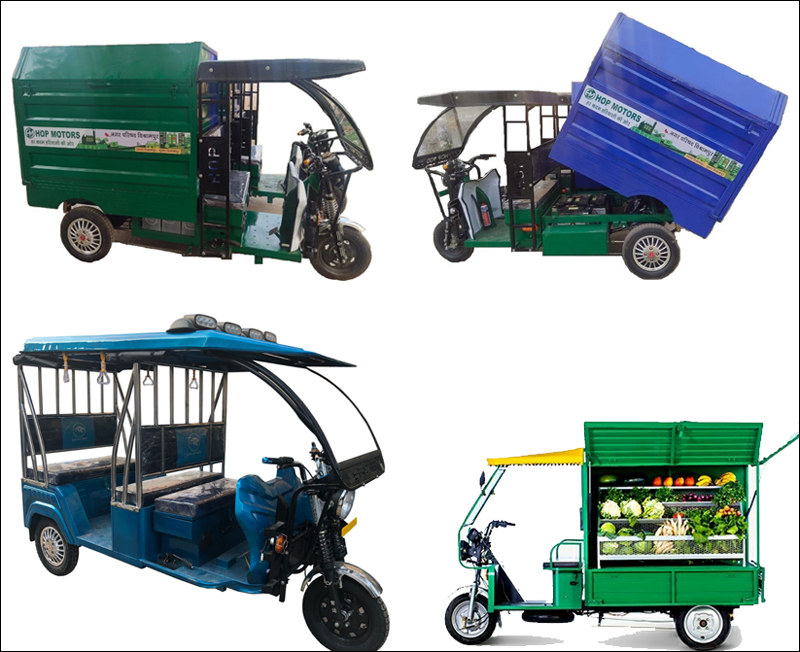India’s EV market is being driven by cheap public vehicles says Satyen K. Bordoloi as he outlines how it could lead a global shift
In December 2020, I witnessed a new vehicle in Guwahati. Regular buses don’t ply on interior routes serviced by cycle rickshaws, auto-rickshaws and trekkers i.e. modified SUVs like Tata Sumo. 8 months into the pandemic, I found the city full of electric rickshaws – called tomtoms locally – that ferried up to 6 people on these routes. Besides ease of driving and cost-effectiveness, their popularity also rested on the less paperwork they demanded.
Since then, I’ve spotted these ‘tomtoms‘ all over India. Along with them, electric mopeds have also become hugely popular in India’s growing home delivery market. Yet, if you go through data on nations where EVs are sold the most, India does not feature anywhere in the top 25 or 50 nations even though they should easily be in the top ten.
As per industry body FADA – Federation of Automobile Dealers Associations – India sold 4,29,217 EVs in the financial year 2021-22, a growth of 218.36 per cent year on year. Compare this to the US which saw 487,000 new electric cars sold in 2021. Of the 4,29,217 EVs, only about 18,000 were electric cars. While in the US it is expensive consumer vehicles like Teslas priced as high as $60,000 that are driving EV adoption, in India’s market is dominated by passenger vehicles selling for less than $1,000.

Outside of the limelight, a quiet EV revolution is taking place in India led not by big vehicle manufacturers but by these jugados – tinkerers, making public transportation.
Jugad – The Tinkering
As per this New York Times article, about 15 years ago “Indian tinkerers and small businesses began importing electric motors and lead-acid batteries from China to assemble cheap vehicles.” This created a space for a local EV startup ecosystem which the government of India’s push for EVs has aided.

Take the company making the tomtoms of Assam: Hop Motors. There are very few articles written about this Faridabad-based company, yet they have an enviable line of products from electric motorcycles and garbage disposal vans to golf carts and passenger vehicles. With the true spirit of tinkering into innovation, they are dominating at price ranges bigger players can’t compete yet. They mostly assemble vehicles with key components being imported.

(Image Credit: Hop Motors)
Bengaluru-based Zuink Retrofit, on the other hand, has gone local. A subsidiary of scooter sharing company Bounce, it can convert your petrol scooter to electric in four hours flat for a sum of Rs. 26,999. The best thing is that their Retrofit Kit is designed, developed, manufactured, and assembled in India. They plan to set up a battery swapping network strategically located in the city.

On the opposite side of the spectrum to Zuink, is Hyderabad-based Godi India, an advanced cell and supercapacitor manufacturer that has India’s largest R&D structure and has recently onboarded 30 PhDs to design solutions for e-mobility and stationary storage systems. It seems to have made progress in the development of indigenous lithium-ion cell manufacturing.

Electric Cycles
Recently Flipkart organized the Big Billion Days Sale from 23rd – 30th September. On the first day of the sale, the entire stock of Enigma 700C range of electric cycles from Ninety-One Cycles sold out. The reason: for the first time in the longest time, the price of electric cycles went below the psychological barrier of ₹20,000. One could buy them for as low as ₹18,000 with the addition of Super Coins.
India is the greatest cycling nation in the world. Hundreds of millions of people – including this author – use cycles for daily commutes and work. E-cycles are hence waiting to explode on the Indian scene. The only problem is the price.
Apurav Jain, GM Electric Cycles at Ninety-One, had told Sify in April that they couldn’t get the price below ₹20,000. When I reached out to him to enquire about the discount offered by Flipkart, he said those were offered by the platforms and not them. He said that the way things stood right now, e-cycles below ₹20,000 are “not sustainable.”
This is where the government of India could step in by measures like lowering taxes and subsidizing buying of e-cycles at least till the industry gets on its feet.
The need in India
Not only is pollution on the rise in India, but the rising prices of petrol are also a deterrent against internal combustion engines. This has led to one of the lowest penetrations of private vehicles in the world with only 22 cars per 1000 people compared with 980 in the US.
It is hence no surprise what different studies state that India’s EV market is at the cusp of an exponential growth. As per SMEV – Society of Manufacturers of Electric Vehicles – India’s electric vehicle sales are likely to triple this year. Deloitte Touche believes the total electric vehicle sales are likely to jump to 1,644,000 units in FY25 and grow to another 15,331,000 units by 2030.
As per a IVCA-EY-Induslaw Report, EV Sales in India is set to cross 9 million units by 2027. This report also said that $1.7 billion was invested in the EV industry in 2021 by PE/VC investors and has reached $666 million in 2022 so far. The report also mentions that the EV industry as a whole is likely to generate over 10 million direct jobs and 50 million indirect jobs by 2030.
The government’s own estimation – thanks to their own positive policy signaling – points northwards. A NITI Aayog and TIFAC (Technology Information, Forecasting and Assessment Council) report states that EV two-wheelers will reach 100 percent penetration by the financial year 2026-27.
The growth in India’s EVs bodes well for the globe. The Teslas of the world won’t serve South Asia or Africa, but a small startup from India like Hop Motors which has tinkered and achieved success, could. India thus will lead the global EV revolution in some of the parts of the world where it matters most.
It is not expensive EVs but reasonable ones, not big companies with deep pockets but small ones with the spirit of ‘jugad’ that are driving India’s EV revolution. And just as well. If India can make the world’s cheapest space rockets, surely, we can do the same to EVs.
In case you missed:
- Would an Electric Plane Have Reduced the Air India Crash Death Toll?
- Rise of Generative AI in India: Trends & Opportunities
- You’ll Never Guess What’s Inside NVIDIA’s Latest AI Breakthrough
- Why Elon Musk is Jealous of India’s UPI (And Why It’s Terrifyingly Fragile)
- AI’s Top-Secret Mission: Solving Humanity’s Biggest Problems While We Argue About Apocalypse
- Digital Siachen: How India’s Cyber Warriors Thwarted Pakistan’s 1.5 Million Cyber Onslaught
- Meet Manus AI: Your New Digital Butler (don’t ask it to make coffee yet)
- Quantum Leaps in Science: AI as the Assembly Line of Discovery
- AI Washing: Because Even Your Toothbrush Needs to Be “Smart” Now
- Digital Siachen: Why India’s War With Pakistan Could Begin on Your Smartphone










5 Comments
metrum.org (Metrology: The Forgotten Science) is the web-site devoted
to typically the memory of Livio Catullo Stecchini.
The Persian Wars, The Origin of Money in Greece and some other historical events.
Superb, what a website it is! This website provides helpful facts to
us, keep it up.
Absolutely with you it agree. It is actually great idea. It is able to give you
support.
I love it whenever people get together and share ideas.
Great blog, keep it up!
Incredible loads of awesome information!